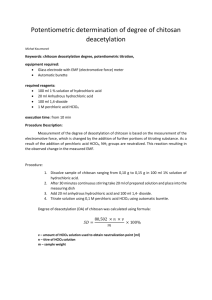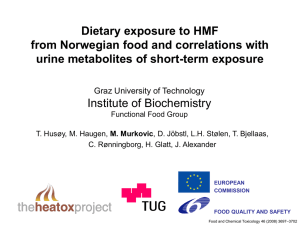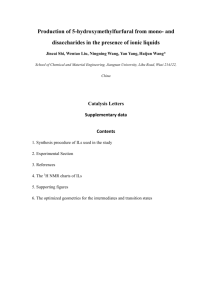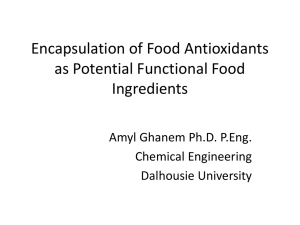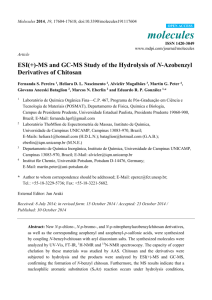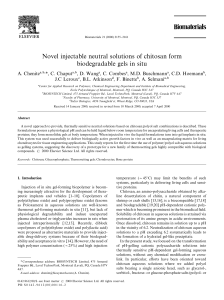070715182723ChitosanAbstract_SusChemE2015
advertisement
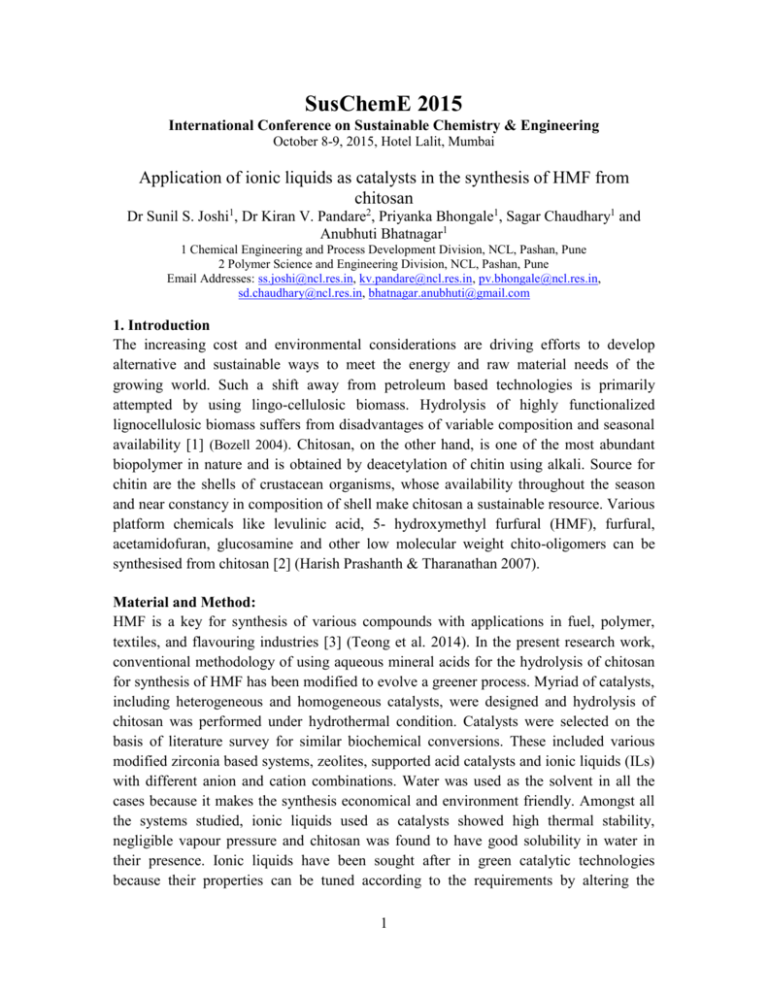
SusChemE 2015 International Conference on Sustainable Chemistry & Engineering October 8-9, 2015, Hotel Lalit, Mumbai Application of ionic liquids as catalysts in the synthesis of HMF from chitosan Dr Sunil S. Joshi1, Dr Kiran V. Pandare2, Priyanka Bhongale1, Sagar Chaudhary1 and Anubhuti Bhatnagar1 1 Chemical Engineering and Process Development Division, NCL, Pashan, Pune 2 Polymer Science and Engineering Division, NCL, Pashan, Pune Email Addresses: ss.joshi@ncl.res.in, kv.pandare@ncl.res.in, pv.bhongale@ncl.res.in, sd.chaudhary@ncl.res.in, bhatnagar.anubhuti@gmail.com 1. Introduction The increasing cost and environmental considerations are driving efforts to develop alternative and sustainable ways to meet the energy and raw material needs of the growing world. Such a shift away from petroleum based technologies is primarily attempted by using lingo-cellulosic biomass. Hydrolysis of highly functionalized lignocellulosic biomass suffers from disadvantages of variable composition and seasonal availability [1] (Bozell 2004). Chitosan, on the other hand, is one of the most abundant biopolymer in nature and is obtained by deacetylation of chitin using alkali. Source for chitin are the shells of crustacean organisms, whose availability throughout the season and near constancy in composition of shell make chitosan a sustainable resource. Various platform chemicals like levulinic acid, 5- hydroxymethyl furfural (HMF), furfural, acetamidofuran, glucosamine and other low molecular weight chito-oligomers can be synthesised from chitosan [2] (Harish Prashanth & Tharanathan 2007). Material and Method: HMF is a key for synthesis of various compounds with applications in fuel, polymer, textiles, and flavouring industries [3] (Teong et al. 2014). In the present research work, conventional methodology of using aqueous mineral acids for the hydrolysis of chitosan for synthesis of HMF has been modified to evolve a greener process. Myriad of catalysts, including heterogeneous and homogeneous catalysts, were designed and hydrolysis of chitosan was performed under hydrothermal condition. Catalysts were selected on the basis of literature survey for similar biochemical conversions. These included various modified zirconia based systems, zeolites, supported acid catalysts and ionic liquids (ILs) with different anion and cation combinations. Water was used as the solvent in all the cases because it makes the synthesis economical and environment friendly. Amongst all the systems studied, ionic liquids used as catalysts showed high thermal stability, negligible vapour pressure and chitosan was found to have good solubility in water in their presence. Ionic liquids have been sought after in green catalytic technologies because their properties can be tuned according to the requirements by altering the 1 combinations of cations and anions. Their application in biomass conversion has led to development of several processes such as hydrolysis, alcoholysis and hydrogenation for conversion of sugars. 3. Significant Results and Discussion: IR and NMR studies performed for catalyst characterization revealed the nature and structure of the IL and it was found to have a selectivity of 25% towards the product. Once the most suitable ionic liquid was defined for the process; a detailed parameter optimization helped in analyzing the sensitivity of the reaction towards duration, temperature and catalyst loading. 30 100 25 80 20 (%) 60 15 40 10 Conversion(%) Synthesis of HMF from Chitosan 20 5 0 0 IL4 ZnCl2 H beta IL1 Catalyst Selectivity of HMF(%) Yield of HMF (%) IL1/ silica gel Conversion of CHT(%) Figure 1: Synthesis of HMF from Chitosan using different catalysts 2 g of chitosan, 2 wt % of catalyst in 100 mL of deionized water; reaction temperature 180 °C and reaction time 180 minutes. Parameter HMF Time Temperature Catalyst Catalyst: Chitosan Conversion (%) Selectivity (%) Yield (%) 120 min 1800C Ionic liquid 1 1:1 78 25 19 Figure 2: Best reaction conditions for desired products obtained after parameter optimization 2 4. Conclusions: It was brought out through this work that chitosan undergoes acid hydrolysis during synthesis of HMF. The environmental impact of acid hydrolysis of chitosan was assessed for the synthesis of HMF. E factor was found to be 6.4 while the atom efficiency was 70%. Thus it is emphasized that there is a scope of improvement in the process to make it more competent by process intensification. References: [ 1] Bozell, J.J., RENEWABLE FEEDSTOCKS FOR THE PRODUCTION OF CHEMICALS [ 2] Harish Prashanth, K.V. & Tharanathan, R.N., Trends in Food Science & Technology, 18(3), 2007. pp.117–131. [ 3] Teong, S.P., Yi, G. & Zhang, Y., Green Chemistry, 16(4), 2014. pp.2015–2026. 3
